Rapid fabrication of zwitterionic sulfobetaine vinylimidazole-based monoliths via photoinitiated copolymerization for hydrophilic interaction chromatography
Qiqin Wng,Lingjue Sun,Huihui Wu,Ning Deng,Xinglong Zho,Jingwei Zhou,Tingting Zhng,Hi Hn,**,Zhengjin Jing,d,*
aInstitute of Pharmaceutical Analysis,College of Pharmacy,Jinan University,Guangzhou,510632,China
bAnhui Prevention and Treatment Center for Occupational Disease,Anhui No.2 Provincial People's Hospital,Hefei,230041,China
cKey Laboratory of Environment-Friendly Chemistry and Application of Ministry of Education,Lab of Biochemistry,College of Chemistry,Xiangtan University,Xiangtan,Hunan,411105,China
dDepartment of Pharmacy and Guangdong Province Key Laboratory of Pharmacodynamic Constituents of Traditional Chinese Medicine&New Drug Research,Jinan University,Guangzhou,510632,China
ABSTRACT
Zwitterionic sulfobetaine-based monolithic stationary phases have attracted increasing attention for their use in hydrophilic interaction chromatography.In this study,a novel hydrophilic polymeric monolith was fabricated through photo-initiated copolymerization of 3-(3-vinyl-1-imidazolio)-1-propanesulfonate(SBVI)with pentaerythritol triacrylate using methanol and tetrahydrofuran as the porogenic system.Notably,the duration for the preparation of this novel monolith was as little as 5 min,which was significantly shorter than that required for previously reported sulfobetaine-based monoliths prepared via conventional thermally initiated copolymerization.Moreover,these monoliths showed good morphology,permeability,porosity(62.4%),mechanical strength(over 15 MPa),column efficiency(51,230 plates/m),and reproducibility(relative standard deviations for all analytes were lower than 4.6%).Mechanistic studies indicated that strong hydrophilic and negative electrostatic interactions might be responsible for the retention of polar analytes on the zwitterionic SBVI-based monolith.In particular,the resulting monolith exhibited good anti-protein adhesion ability and low nonspecific protein adsorption.These excellent features seem to favor its application in bioanalysis.Therefore,the novel zwitterionic sulfobetaine-based monolith was successfully employed for the highly selective separation of small bioactive compounds and the efficient enrichment of N-glycopeptides from complex samples.In this study,we prepared a novel zwitterionic sulfobetaine-based monolith with good performance and developed a simpler and faster method for preparation of zwitterionic monoliths.
Keywords:
Zwitterionic monolith
Sulfobetaine
Photo-initiated copolymerization
Hydrophilic interaction chromatography
Complex sample
1.Introduction
Owing to their excellent biocompatibility,hydrophilicity,and ultralow-fouling capacity, zwitterionic sulfobetaine-based materials have been commonly employed as next-generation biomaterials to modify bio-interfaces in the fields of medicine,biology,bionics,and separation science[1-4].For instance,poly(sulfobetaine),employed as an implant material and device,can reduce protein adsorption and limit cellular adhesion and inflammatory response[3].Various sulfobetaine-based packing columns,including commercial zwitterionic hydrophilic interaction liquid chromatography(ZIC-HILIC)[5],N,N-dimethyl-N-methacryloxyethyl-N-(3-sulfopropyl)ammonium betaine(SPE)-[6],3-[2-(acrylamido)-ethyldimethylammonio]propane sulfonate-[7],and acrylamide-type sulfobetaine-based[8]stationary phases,have been developed for the separation of polar analytes or enrichment of glycopeptides via hydrophilic or electrostatic interactions[9].Although good chromatographic performance was obtained,the preparation process of the packed column was very complicated,which limits its further application[10-12].
Recently,monolithic stationary phases have attracted close attention because of their easy preparation(thermally initiated copolymerization of functional monomers and crosslinkers),good column efficiency,high permeability and stability,and low cost[13-18].Therefore,a series of sulfobetaine-based zwitterionic hydrophilic polymeric monoliths,including SPE[19-24],1-(3-sulphopropyl)-4-vinylpyridinium-betaine[25],N,N-dimethyl-N-acryloyloxyethyl-N-(3-sulfopropyl)ammonium betaine[26,27],and N,N-dimethyl-N-(3-methacrylamidopropyl)-N-(3-sulfopropyl)
ammonium betaine[28],were successively developed to overcome the above mentioned shortcomings of the packed columns.These monoliths exhibited better chromatographic performance.Further studies also showed that the properties of crosslinker have a significant influence on the performance of these sulfobetaine-based zwitterionic hydrophilic monoliths in terms of column polarity,selectivity,and efficiency[29].Moreover,mechanistic studies indicated that the spatial arrangement of charged moieties(quaternary ammonium group and sulfonyl group)[30]or the sample solvent[31]also affects column performance.Large-scale zwitterionic sulfobetaine-based monoliths with a capillary(400μm i.d.and 800μm o.d.)[32]or stainless-steel column(100 mm×2.0 mm i.d.) [33] have also been developed for micro-liquid chromatography(LC)or traditional high performance liquid chromatography(HPLC)/supercritical fluid chromatography.These findings demonstrate that sulfobetaine-based monoliths have great application potential for HILIC with good selectivity and efficiency.
As an important sulfobetaine derivative, 3-(3-vinyl-1-imidazolio)-1-propanesulfonate (SBVI) has been previously employed to prepare polymeric brushes for anti-fouling,anti-fog,and anti-frost applications[34-37].Jiang and co-workers[34]found that the introduction of vinylimidazole can significantly improve the tensile and compressive mechanical properties of the obtained materials compared with those of sulfobetaine methacrylate-based hydrogels.Despite its good anti-fouling and mechanical properties,SBVI has never been exploited for the preparation of zwitterionic HILIC monolithic stationary phases.Additionally,compared with that of traditional thermally initiated copolymerization,photo-initiated copolymerization involves a significantly faster preparation process(only a few minutes),with lower energy consumption and cost[38].
To enrich the types of sulfobetaine-based monoliths and simplify their preparation process,a novel monolith was developed by employing SBVI as a functional monomer and pentaerythritol triacrylate(PETA)as a crosslinker via photo-initiated copolymerization.The physicochemical properties of the resulting monoliths were systematically investigated.The chromatographic separation ability,anti-protein adsorption ability,and enrichment capacity for N-glycopeptide of the SBVI-based monolith were evaluated using various polar analytes,fluorescence-labeled bovine serum albumin(FITC-labeled BSA),and tryptic digest of hIgG,respectively.
2.Experimental
2.1.Materials and reagents
The compounds 1,3-propanesultone and 1-vinylimidazole were purchased from Energy Chemical(Shanghai,China),and HPLC-grade acetonitrile(ACN)and methanol(MeOH)were obtained from Merck(Shanghai,China).All other chemicals,including benzoin dimethylether (DMPA),PETA,2,6-di-tert-butyl-4-methylphenol(BHT),tetrahydrofuran(THF),3-(trimethoxysilyl)propyl methacrylate(γ-MAPS),toluene,thiourea,benzoic acid(BA),2-hydroxybenzoic acid(2-HB),2,5-dihydroxybenzoic acid(2,5-DHB),3,5-dihydroxybenzoic acid (3,5-DHB),3,4,5-trihydroxybenzoic acid(3,4,5-THB),thymine,uracil,adenine,adenosine,phenol,hydroquinone,pyrogallic acid,phloroglucinol,urea,allantoin,BSA,FITC-labeled BSA,phosphate buffered saline(PBS),hIgG,trypsin,ammonium formate(AF),and trifluoroacetic acid(TFA),were purchased from Aladdin Chemical(Shanghai,China).Ultraviolet(UV)transparent capillaries(100μm i.d.× 365μm o.d.)obtained from Ruifeng Chromatography Ltd.(Handan,China)were used to prepare the monoliths.Deionized water filtered through a 2μm membrane was used for all experiments.
2.2.Instrumentation
The photo-initiated copolymerization of SBVI was carried out using UV light at 254 nm and 50 Hz(ALYS Labware,Lausanne,Switzerland).A Zeiss ULTRA 55 field-emission scanning electron microscope(Oberkochen,Germany)was employed for scanning electron microscopy(SEM)and energy-dispersive X-ray spectrometry(EDS)tests of the novel monolith at acceleration voltages of 5 and 15 kV,respectively.A Micromeritics Auto Pore 9500 automatic mercury porosimeter(Norcross,GA,USA)was used to measure pore size distribution.The zeta potential of the resulting monolith was measured using a Malvern Nano-ZSζ-potential meter(Malvern Panalytical,Malvern,UK).An inverted fluorescence microscope(Olympus,Tokyo,Japan)was used to evaluate the adsorption of FITC-labeled BSA on the monolith.Moreover,the adsorbed protein amount was tested using a Synergy LX microplate reader(BioTek,Winooski,VT,USA).Matrix assisted laser desorption ionization time of flight mass spectrometry(MALDI-TOF MS)analysis was performed using a Bruker UltrafleXtreme MALDI TOF/TOF mass spectrometer(Bruker Daltonics,Billerica,MA,USA)to identify the enriched N-glycopeptides.Only peptides containing the Asn-X-Ser/Thr/Cys sequence(X is any amino acids other than Pro)were identified as N-glycopeptides.
2.3.Synthesis of the SBVI monomer
SBVI was synthesized according to a previously published method[34](Fig.S1).First,in a 500 mL three-neck round bottom flask,14.8 g(120 mmol)of 1,3-propanesultone was dissolved in 200 mL of ACN.Then,9.4 mL(100 mmol)of 1-vinylimidazole was slowly dropped into the three-neck round-bottom flask under N2protection.After two days,the reaction was stopped,and the resulting precipitate was separated and washed thrice with ether.Finally,the polymerization inhibitor BHT was added for the longterm storage of the target compound,and the yield of SBVI was calculated to be 80%.The synthesis of the SBVI monomer was confirmed using MS(Fig.S2),nuclear magnetic resonance(NMR)spectroscopy,and elemental analysis.Electrospray ionization-MS m/z:217[M+H]+;1H NMR(D2O,300 MHz):9.02(s,1H),7.73(s,1H),7.57(s,1H),7.08(t,1H),5.75(d,1H),5.37(d,1H),4.35(t,2H),2.88(t,2H),2.28(m,2H);element content(%,m/m):40.31% for C,15.50% for N,5.73% for H,12.25% for S,and 24.72% for O.
2.4.Rapid fabrication of the SBVI functionalized polymeric monoliths
To provide anchoring sites for the bulk polymer,the inner surfaces of the UV-transparent capillaries were first modified with γ-MAPS according to previously described methods[16].The polymerization mixture was prepared by accurately weighing the designated amounts of the functional monomer(SBVI),crosslinker(PETA),porogen(a mixture of MeOH and THF),and photo-initiator(DMPA,approximately 1%(m/m)with respect to the monomer)into a 2.0 mL glass vial.After ultrasonication for 10 min,the mixture was filled into pre-treated capillaries,sealed with GC septa,and placed under preheated UV light.The photo-initiated copolymerization lasted for 5 min,and the resultant monoliths were flushed thoroughly with MeOH.For the SEM and EDS analyses,a piece of monolith(approximately 1 cm)was cut from the column.The residual mixture inside the 2.0 mL glass vial was simultaneously copolymerized.The obtained bulk polymer was crushed into small pieces,Soxhlet extracted with MeOH for 24 h,and dried under vacuum at 40°C for 6 h.Finally,the dried materials were subjected to a series of physicochemical analyses,including pore size distribution,zeta potential,and specific surface area analyses.
2.5.Micro-LC separation of small bioactive compounds
A self-assembled nano-HPLC system was used to evaluate the separation performance of the zwitterionic SBVI-based monoliths.It consisted of a DiNa-S nano gradient pump(Techno Alpha,Tokyo,Japan),a Shimadzu SPD-15C UV detector(Kyoto,Japan)with a labmade on-column detection system,and a Valco four-port injection valve with a 20-nL internal loop(Houston,TX,USA).A commercial Unimicro Trisep?Workstation 2003(Shanghai,China)was used to collect data,and the obtained chromatograms were converted to.txt files and then redrawn using Microcal OriginPro 2018(OriginLab,Northampton,MA,USA).The mobile phases for the micro-LC experiments were prepared by mixing appropriate amounts of water or ammonium formate with ACN.Diluted formic acid was used to adjust the pH of the ammonium formate buffer.All samples were dissolved in the corresponding mobile phases.Both sample solutions and mobile phases were filtered through a 0.22-μm membrane.
3.Results and discussion
3.1.Rapid preparation of the zwitterionic SBVI-based hydrophilic monoliths
Zwitterionic hydrophilic monoliths with excellent selectivity and efficiency are highly desirable in separation science.For this purpose,several important parameters,such as the polymerization time,composition of the functional monomer and crosslinker,and weight content and composition of the porogens,were optimized.According to our previous study[16],5 min in situ photo-initiated copolymerization(Fig.1)was selected for preparing zwitterionic SBVI-based hydrophilic monoliths,which was a significantly shorter duration than that used for conventional thermally initiated copolymerization of multi-monomer systems(at least 12 h,such as those functionalized with zwitterionic sulfobetaine[30,32],phosphatidylethanolamine[39],phosphorylcholine[12,40],and choline phosphate[17]).
Considering the significant effect of the composition of the monomer mixture(SBVI and PETA)on the column backpressure and efficiency,the weight ratio of SBVI in the monomer mixture was changed from 60%(C1)to 85%(C6),whereas the other parameters(UV exposure time and the composition of the porogenic mixture)remained constant.The column backpressure decreased with an increasing weight ratio of SBVI(Table 1).Column C3 exhibited acceptable backpressure(2.0 MPa)and good column efficiency(38,323 plates/m),and was therefore selected for further optimization.Next,the total amount of porogen(a mixture of MeOH and THF)was optimized.When the weight content of the porogens decreased from 85%(C8)to 80%(C3),the backpressure and column efficiency increased.However,it was difficult to pump the mobile phase through the C7 column(using 75% porogens).Finally,the influence of the porogen composition was evaluated by changing the weight ratio of MeOH/THF from 75/25(C9)to 85/15(C10).Even a slight change in this weight ratio could significantly affect the column backpressure and efficiency.For example,the backpressure dramatically decreased from 4.5(C9)to 0.4(C10)MPa.In summary,the C3 column possessed the highest column efficiency and acceptable backpressure;therefore,the polymerization conditions associated with this column were selected for further experiments.

Fig.1.Rapid preparation of the zwitterionic poly(SBVI-co-PETA)monolith.SBVI:3-(3-vinyl-1-imidazolio)-1-propanesulfonate;PETA:pentaerythritol triacrylate;DMPA:benzoin dimethyl ether;MeOH:methanol;THF:tetrahydrofuran;UV:ultraviolet.

Table 1Optimization of preparation conditions for poly(SBVI-co-PETA)monolith.
3.2.Characterization of the SBVI-based polymeric monoliths

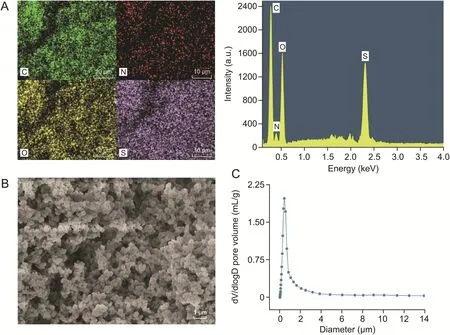
Fig.2.(A)Energy-dispersive X-ray spectrometry(EDS)images,(B)scanning electron microscopy(SEM)image,and(C)pore size distribution graphs of the poly(SBVI-co-PETA)monolith.SBVI:3-(3-vinyl-1-imidazolio)-1-propanesulfonate;PETA:pentaerythritol triacrylate.
The Van Deemter curve(Fig.3B)shows that the highest column efficiency for thiourea is 51,230 plates/m(H=19.52μm)at a linear velocity of 0.33 mm/s.Furthermore,the run-to-run,day-to-day,column-to-column,and batch-to-batch reproducibility of the novel monolith was investigated,and acceptable results were obtained(relative standard deviations for all analytes were less than 4.6%,Table S1).Fig.3C presents a typical HILIC retention behavior on the SBVI-based monolith over ACN ranging from 10% to 95%.Moreover,zeta-potential tests revealed that the surface of the SBVI-based monolith was almost negatively charged,and the absolute value of zeta-potential decreased with decreasing buffer pH from 10 to 3(Fig.3D).Therefore,both hydrophilic and electrostatic interactions are believed to contribute to the retention of charged polar analytes on SBVI-based monoliths.
To further investigate the influence of hydrophilic and electrostatic interactions on the separation ability of the SBVI-based monolith,benzoic acid and its derivatives(BA,2-HB,2,5-DHB,3,5-DHB,and 3,4,5-THB,which have pKavalues of 4.19,2.98,2.97,4.04,and 4.41,respectively)were employed as analytes.The buffer pH varied from 3 to 9,whereas the ACN content(85%)and buffer concentration(20 mM AF)remained constant.As shown in Fig.4A,the buffer pH had almost no effect on the retention of the three analytes(BA,2-HB and 2,5-DHB),indicating that the contribution of electrostatic repulsion interactions to their retention could be neglected under high ACN content.In contrast,the retention of 3,4,5-THB and 3,5-DHB dramatically increased with increasing buffer pH.This could be explained by their deprotonation,leading to more negative charge and higher hydrophilicity.To further study the electrostatic interactions,the ACN content in the mobile phase was reduced to 20%,where the hydrophilic interaction was suppressed to the utmost extent.As shown in Fig.4B,the retention of all five acids decreased with increasing buffer pH,which can be attributed to the increased electrostatic repulsion between the acidic analytes and the negatively charged SBVI-based zwitterionic stationary phase.
3.3.Application of zwitterionic monolithic columns
3.3.1.Chromatographic application of the SBVI-based monolith
To investigate the separation selectivity of the SBVI-based monolith,different polar compounds,including nucleobases and nucleosides,phenols,benzoic acid and its derivatives,and cosmetic additives,were used as analytes.Under the selected separation conditions(ACN:H2O;95:5,V/V),hydrophilic interactions could dominate the retention on the monolith.As shown in Fig.5A,the separation of toluene,thymine,uracil,adenine,and adenosine was achieved within 6 min with an acceptable peak shape and selectivity.A good separation ability was further demonstrated by the separation of the four phenols(Fig.5B).Subsequently,20 mM of ammonium formate(pH 5.0)in ACN:H2O(85:15,V/V)was used as the mobile phase for baseline separation of benzoic acid and its derivatives within 30 min(Fig.5C).According to the above retention mechanism(Fig.4A),hydrophilic interactions could contribute to the retention and separation of acidic analytes on the SBVI-based monolith.Finally,the applicability of the SBVI-based monolith was further verified through the fast separation of two highly polar additives,urea and allantoin,in cosmetic products(Fig.5D).
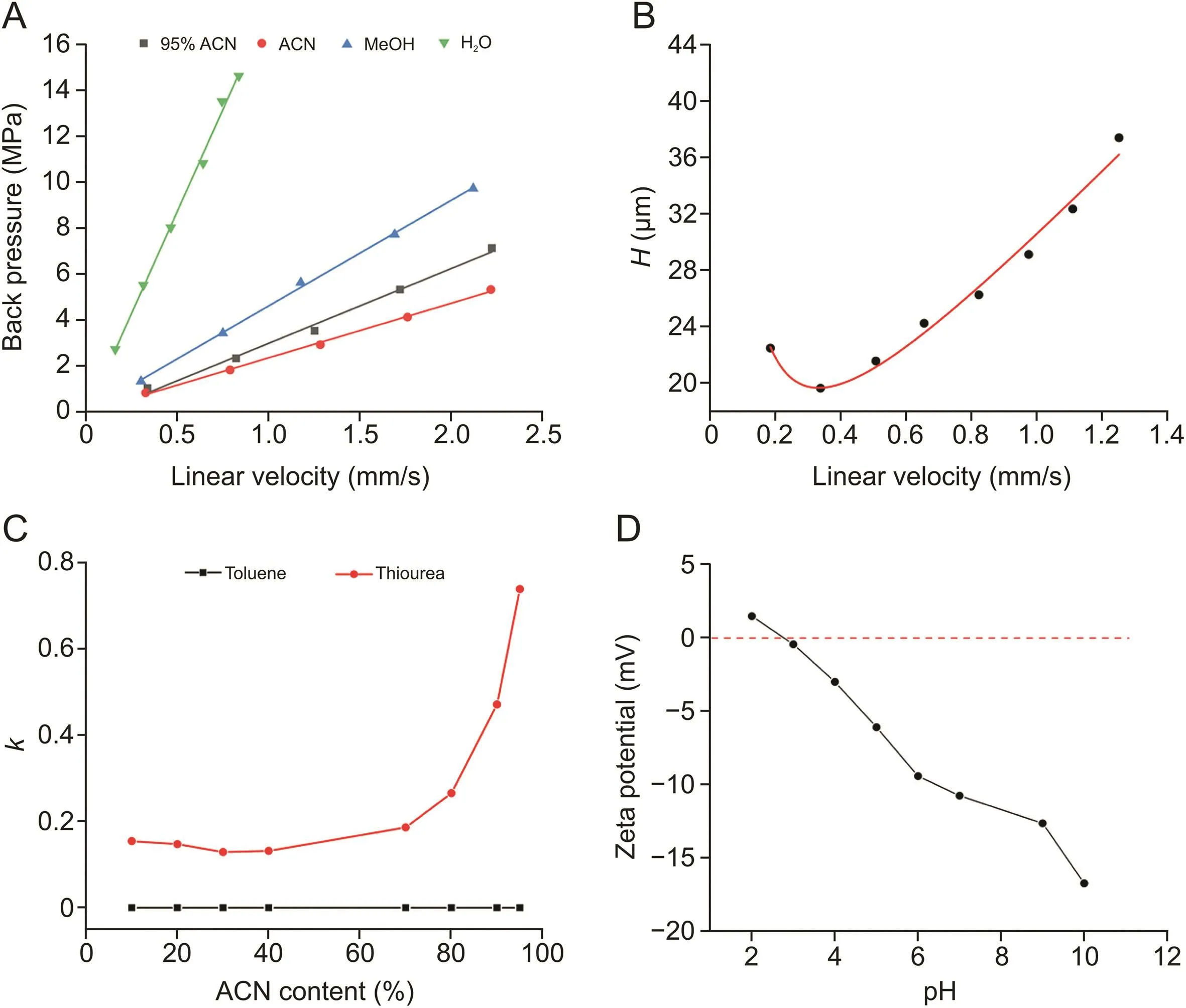
Fig.3.(A)Relationship between linear velocity and column backpressure of the poly(SBVI-co-PETA)monolith.Experimental conditions:column dimension,130 mm×100μm i.d.;mobile phase,acetonitrile(ACN),ACN:H2O(95:5,V/V),methanol(MeOH),and H2O.(B)Van Deemter curve of the poly(SBVI-co-PETA)monolith.Experimental conditions:column dimension,135 mm ×100μm i.d.;mobile phase,ACN:H2O(95:5,V/V).(C)Hydrophilic interaction liquid chromatography(HILIC)retention behavior of the poly(SBVI-co-PETA)monolith over ACN ranging from 10% to 95%.Experimental conditions:column dimension,135 mm×100μm i.d.;mobile phase,ACN:H2O(V/V);flow rate,800 nL/min.k:retention factor.(D)Zeta-potential measurement of the poly(SBVI-co-PETA)monolith.For(A),(B),and(C),detection wavelength,254 nm;injection,20 nL;samples,toluene(dead time marker)and thiourea.SBVI:3-(3-vinyl-1-imidazolio)-1-propanesulfonate;PETA:pentaerythritol triacrylate.
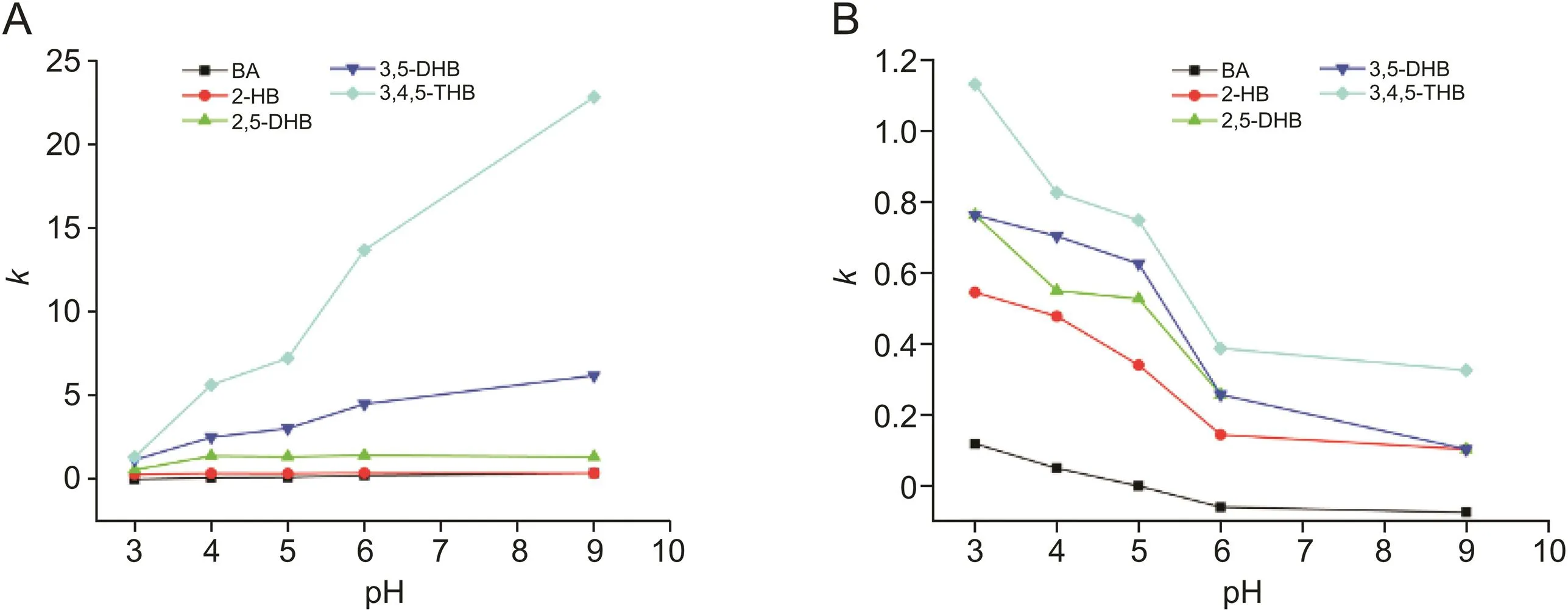
Fig.4.Investigation of the hydrophilic and electrostatic interactions on the poly(SBVI-co-PETA)monolith under the mobile phases:(A)20 mM ammonium formate(AF)in acetonitrile(ACN):H2O(85:15,V/V)and(B)20 mM AF in ACN:H2O(20:80,V/V).Experimental conditions:column dimension,135 mm×100μm i.d.;detection wavelength,214 nm;fl ow rate,700 nL/min;injection,20 nL;sample,benzoic acid(BA),2-hydroxybenzoic acid(2-HB),2,5-dihydroxybenzoic acid(2,5-DHB),3,5-dihydroxybenzoic acid(3,5-DHB),and 3,4,5-trihydroxybenzoic acid(3,4,5-THB).k:retention factor.SBVI:3-(3-vinyl-1-imidazolio)-1-propanesulfonate;PETA:pentaerythritol triacrylate.
3.3.2.Anti-protein adsorption ability of the SBVI-based monolith
A layer of zwitterionic hydrophilic coating can effectively reduce nonspecific adsorption of proteins to solid/liquid interfaces[42],which could improve the column performance and lifetime in bioanalysis.Therefore,it is of great interest to investigate the antiprotein adsorption ability of poly(SBVI-co-PETA)monoliths.A poly(PETA)monolith was prepared for comparison and BSA was used as the analyte.First,a standard curve was established by measuring the fluorescence intensity of a series of sample solutions(0.0625,0.125,0.25,0.5,0.75,and 1.0 mg/mL BSA in 50 mM PBS).Subsequently,5 mg of the dried poly(SBVI-co-PETA)or poly(PETA)polymeric powder was added into the BSA solution(250μL,0.5 mg/mL,c0).The mixture was shaken for 4 h at room temperature and then centrifuged.The fluorescence intensity of the supernatant was tested.The measured BSA concentration was calculated as c1.Finally,the nonspecific protein adsorption rate on the monolith was calculated according to the following equation:nonspecific protein adsorption rate=(1-c1/c0)×100%.The adsorbed protein on the zwitterionic poly(SBVI-co-PETA)monolith(approximately 7%)was found to be much lower than that of the poly(PETA)monolith(approximately 40%).Furthermore,an FITC-labeled BSA solution was pumped through the poly(SBVI-co-PETA)monolith for 0.5 h(Fig.6A)and then washed with water for 1 h(Fig.6B).The monolith without an FITC-labeled BSA solution pumped through was used as control column for comparison(Figs.6C and D).As shown in Fig.6,the strong fluorescence on the poly(SBVI-co-PETA)monolith was significantly weakened after flushing with water(Fig.6B).These results indicated that the zwitterionic SBVI-based monolith had good anti-protein adsorption ability.
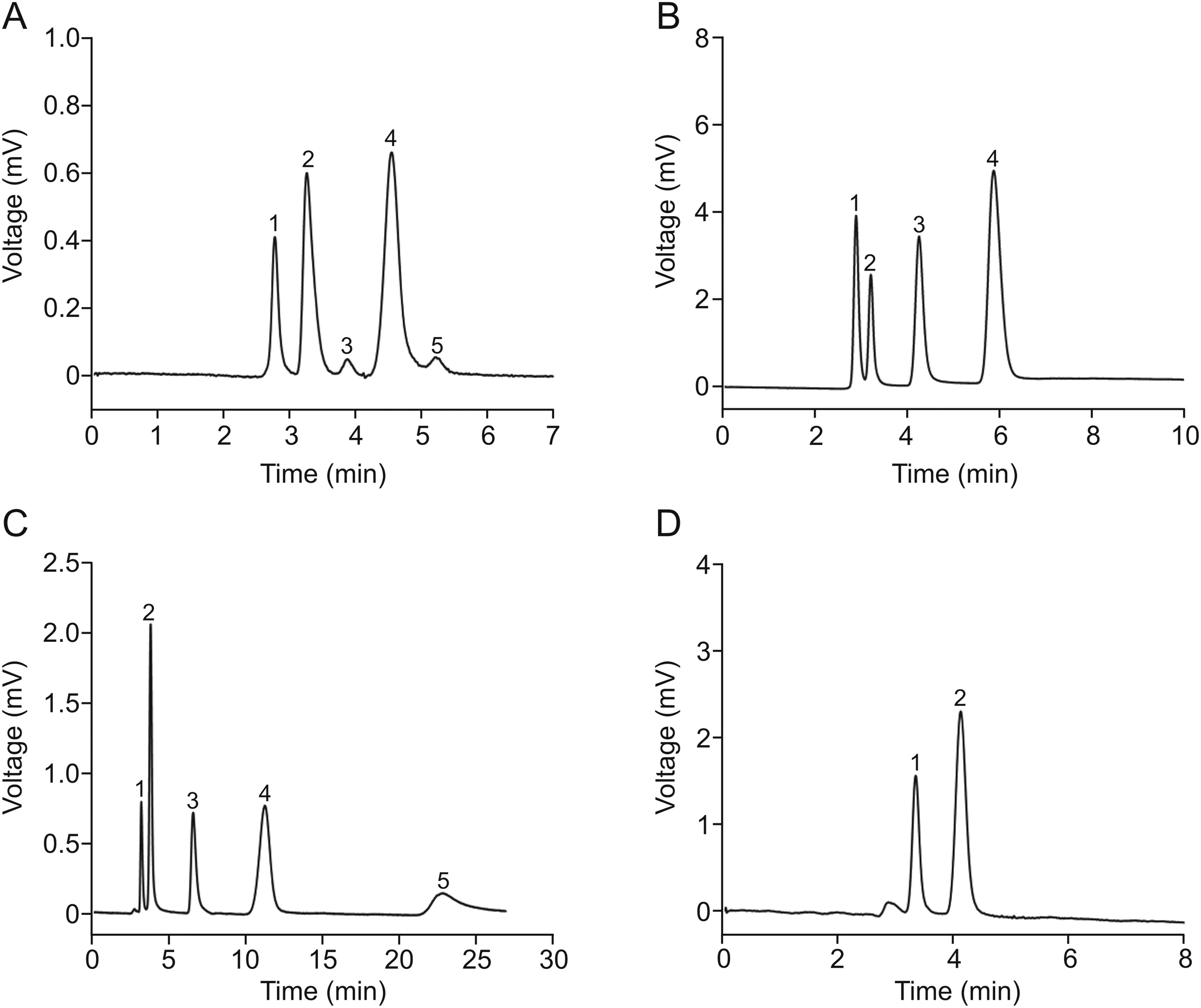
Fig.5.Chromatographic evaluation of the poly(SBVI-co-PETA)monolith(column dimension:135 mm×100μm i.d.).(A)Separation of nucleobases and nucleosides:mobile phase,acetonitrile(ACN):H2O(95:5,V/V);flow rate,700 nL/min;detection wavelength,254 nm;samples:(1)toluene,(2)thymine,(3)uracil,(4)adenine,and(5)adenosine.(B)Separation of phenols:mobile phase,ACN:H2O(95:5,V/V);flow rate,700 nL/min;detection wavelength,214 nm;samples:(1)phenol,(2)hydroquinone,(3)pyrogallic acid,and(4)phloroglucinol.(C)Separation of benzoic acid and its derivatives:mobile phase,20 mM AF pH 5.0 in ACN:H2O(85:15,V/V);flow rate,700 nL/min;detection wavelength,214 nm;samples:(1)benzoic acid,(2)2-hydroxybenzoic acid,(3)2,5-dihydroxybenzoic acid,(4)3,5-dihydroxybenzoic acid,and(5)3,4,5-trihydroxybenzoic acid.(D)Separation of urea and allantoin:mobile phase,ACN:H2O(95:5,V/V);flow rate,700 nL/min;detection wavelength,190 nm;samples:(1)urea and(2)allantoin.SBVI:3-(3-vinyl-1-imidazolio)-1-propanesulfonate;PETA:pentaerythritol triacrylate.
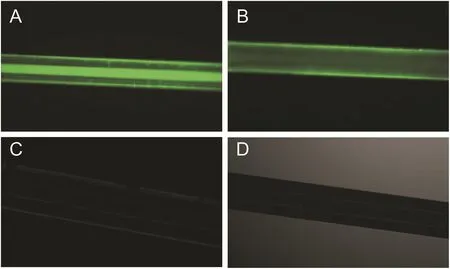
Fig.6.Fluorescence intensity of fluorescence-labeled bovine serum albumin(FITC-labeled BSA)on the poly(SBVI-co-PETA)monolith:(A)before and(B)after washing with H2O,(C)control column without FITC-labeled BSA,and(D)control column under visible light.SBVI:3-(3-vinyl-1-imidazolio)-1-propanesulfonate;PETA:pentaerythritol triacrylate.
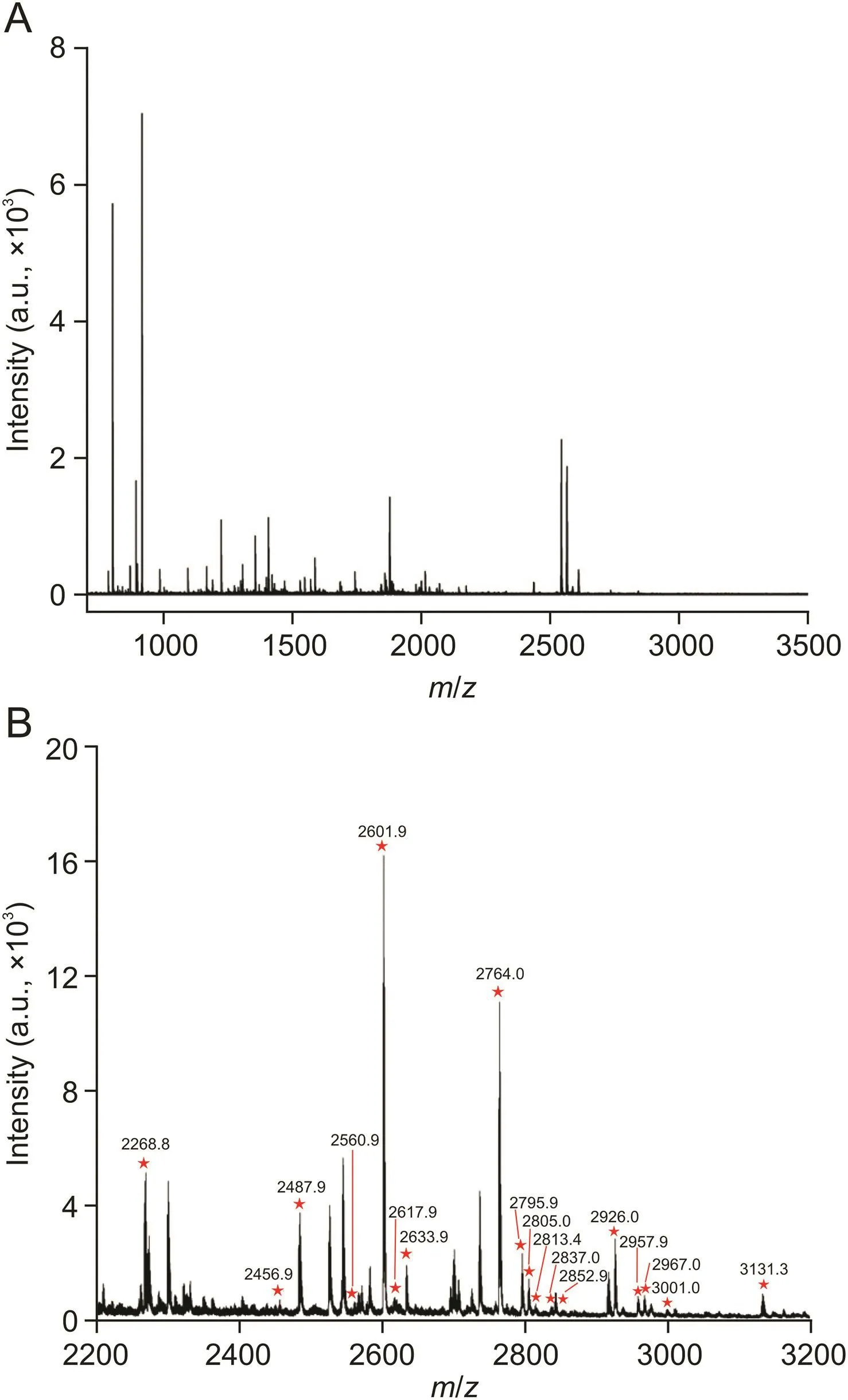
Fig.7.Matrix assisted laser desorption ionization time of flight mass spectrometry spectra(MALDI-TOF MS)of the standard hIgG digestion solution(A)before and(B)after enrichment by the poly(SBVI-co-PETA)monolithic materials; The detected N-glycopeptides.SBVI:3-(3-vinyl-1-imidazolio)-1-propanesulfonate;PETA:pentaerythritol triacrylate.
3.3.3.Enrichment of glycopeptides
Protein glycosylation,one of the major post-translational modifications,plays a crucial role in the development of some chronic or infectious diseases,such as Alzheimer's disease and various autoimmune and inflammatory diseases[43-45].Therefore,it is of great interest to monitor variations in protein glycosylation using highly sensitive analytical methods,such as MALDITOF MS peptide profiling[46,47].However,the MS signal of glycopeptides was suppressed in the presence of high-abundance non-glycopeptides.Therefore,rapid and efficient enrichment is required before MS analysis.Porous materials with good hydrophilicity have shown great capability for glycopeptide enrichment in recent studies[12,45].To evaluate the enrichment capacity of the SBVI-based monolith for glycopeptides,a tryptic digest of hIgG(1 mg)was prepared according to a previous report[15].Subsequently,200μL of the tryptic digest of hIgG was added to 1.5 mg of SBVI-based polymer powder,and the mixture was shaken for 20 min.After centrifugation,the remaining polymer was washed three times with 400μL of buffer A(ACN:H2O:TFA;88:11.9:0.1,V/V/V)to eliminate the interference of non-glycopeptides.Finally,the enriched glycopeptides were eluted with 100μL of buffer B(ACN:H2O:TFA;40:59.9:0.1,V/V/V),and the obtained supernatant was analyzed using MALDI-TOF MS.As shown in Fig.7A,owing to the strong signal suppression from high-abundance non-glycosylated peptides,no glycopeptides were detected via direct analysis of the hIgG tryptic digest.After enrichment with the SBVI-based material,the signal responses of glycopeptides were significantly improved,and 18 N-glycopeptides were detected in the m/z range of 2,200-3,200(Fig.7B).This observed enrichment performance was comparable to that of commercial ZIC-HILIC materials(less than 21 N-glycopeptides[48]).
4.Conclusions
In this study,a novel polymeric monolith employing sulfobetaine vinylimidazole as the functional monomer and PETA as the crosslinker was designed and fabricated via a photoinitiated copolymerization strategy for the first time.Compared to sulfobetaine-based monoliths prepared via thermally initiated copolymerization,this novel monolith could be prepared within only 5 min.The resultant monolith exhibited excellent physicochemical properties in terms of mechanical strength,permeability,and column efficiency,which are beneficial for applications in the fields of small polar molecule separation and enrichment of N-glycopeptides.Moreover,the introduction of zwitterionic SBVI could significantly suppress the nonspecific adsorption of BSA on the polymeric surface,which is a good characteristic for applications in bioanalysis.In summary,this study provides a robust strategy for the development of a novel sulfobetaine-based monolith and also offers a rapid method for the preparation of zwitterionic hydrophilic monoliths.
CRediT author statement
Qiqin Wang:Formal analysis,Validation,Investigation,Data curation,Visualization,Writing-Original draft preparation;Lingjue Sun:Formal analysis,Validation,Investigation,Data curation;Huihui Wu:Methodology,Software;Ning Deng:Methodology,Software;Xianglong Zhao:Validation;Jingwei Zhou:Validation;Tingting Zhang:Methodology;Hai Han:Writing-Reviewing and Editing,Validation;Zhengjin Jiang:Conceptualization,Methodology,Resources,Supervision,Writing-Reviewing and Editing,Project administration,Funding acquisition.
Declaration of competing interest
The authors declare that there are no conflicts of interest.
Acknowledgments
This work was supported by the National Natural Science Foundation of China(Grant Nos.:82173773 and 82073806),the Natural Science Foundation of Guangdong Province,China(Grant Nos.:2020A1515010569 and 2021A0505030039),and Science and Technology Program of Guangzhou, China (Grant No.:202102020729).
Appendix A.Supplementary data
Supplementary data to this article can be found online at https://doi.org/10.1016/j.jpha.2022.05.008.
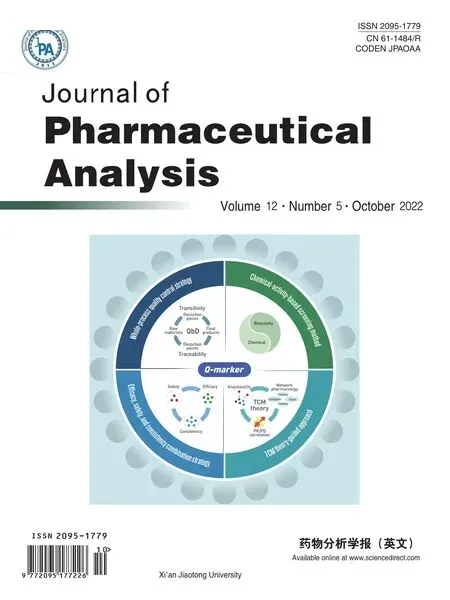 Journal of Pharmaceutical Analysis2022年5期
Journal of Pharmaceutical Analysis2022年5期
- Journal of Pharmaceutical Analysis的其它文章
- Caenorhabditis elegans deep lipidome profiling by using integrative mass spectrometry acquisitions reveals significantly altered lipid networks
- Effective extraction of fluoroquinolones from water using facile modified plant fibers
- Effects of polyol excipient stability during storage and use on the quality of biopharmaceutical formulations
- Evaluation of the metabolism of PEP06,an endostatin-RGDRGD 30-amino-acid polypeptide and a promising novel drug for targeting tumor cells
- Multimodal integrated strategy for the discovery and identification of quality markers in traditional Chinese medicine
- The dynamic metabolic profile of Qi-Yu-San-Long decoction in rat urine using UPLC-QTOF-MSEcoupled with a post-targeted screening strategy
